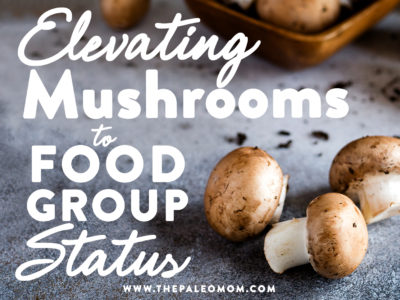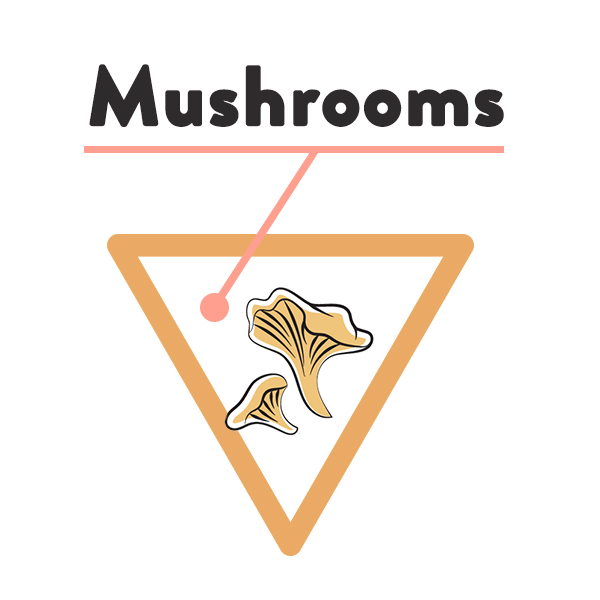 Mushrooms aren’t actually a vegetable, but rather the fruiting bodies of larger fungi, or macromycetes. There are four major phyla of the Fungi kindom—Chytridiomycota, Zygomycota, Ascomycota, and Basidiomycota. Most edible mushrooms belong to the Basidiomycota phylum (which includes approximately 30,000 known species of fungi), including the common mushroom (also called the white mushroom), shiitake, oyster, enoki, maitake, cremini, portabella, puffballs, boletus, and chanterelles. Truffles and morels and are among approximately 40,000 known species of fungi belonging to the Ascomycota phylum.
Mushrooms aren’t actually a vegetable, but rather the fruiting bodies of larger fungi, or macromycetes. There are four major phyla of the Fungi kindom—Chytridiomycota, Zygomycota, Ascomycota, and Basidiomycota. Most edible mushrooms belong to the Basidiomycota phylum (which includes approximately 30,000 known species of fungi), including the common mushroom (also called the white mushroom), shiitake, oyster, enoki, maitake, cremini, portabella, puffballs, boletus, and chanterelles. Truffles and morels and are among approximately 40,000 known species of fungi belonging to the Ascomycota phylum.
Mushrooms feature as a revered food dating back to earliest recorded history. In ancient Greece, mushrooms were reserved for warriors to provide them strength in battle. Egyptian pharaohs prized mushrooms as a delicacy. The ancient Romans reserved mushrooms for festive occasions as they were considered a “Food of the Gods.” In Chinese culture, mushrooms have long been valued as a health food and medicinal, effective to treat a variety of ills. And, as you’ll see in this post, mushrooms actually do earn this pedestal, offering us nutrients that are completely unique in the food supply and which benefit our health in a variety of ways. In fact, prospective studies demonstrate that high mushroom consumption is an important component of a “prudent diet” to reduce cardiovascular disease risk and all-cause mortality (a general marker of health and longevity).
Mushrooms are Nutrient-Dense
Mushrooms are powerhouses of nutrition. A 100-gram serving of the least impressive mushroom (the white or common mushroom), raw, contains a whopping 24% of the RDA of vitamin B2, 18% of vitamin B3, 15% of vitamin B5, 16% of copper, 13% of selenium, 9% each of phosphorous and potassium, and smaller but still impressive amounts of vitamins B1, B6, B9, C and D as well as iron, magnesium, manganese and zinc—all for only 22 calories. And, it just gets better from there!
Nutrients in Mushrooms %DV
(100 gram serving, raw)
| white | oyster | cremini | enoki | maitake | portabella | shiitake | |
| calories | 22 | 43 | 27 | 44 | 37 | 26 | 34 |
| fiber (g) | 1 | 2.3 | 0.6 | 2.7 | 2.7 | 1.5 | 2.5 |
| vitamin B1 | 5 | 8 | 6 | 12 | 10 | 5 | 1 |
| vitamin B2 | 24 | 21 | 29 | 10 | 14 | 28 | 13 |
| vitamin B3 | 18 | 25 | 19 | 30 | 33 | 23 | 24 |
| vitamin B5 | 15 | 13 | 15 | 11 | 3 | 15 | 15 |
| vitamin B6 | 5 | 6 | 6 | 4 | 3 | 5 | 15 |
| vitamin B9 | 4 | 7 | 3 | 13 | 7 | 5 | 4 |
| vitamin B12 | 1 | 0 | 2 | 0 | 0 | 1 | 0 |
| calcium | 0 | 0 | 2 | 0 | 0 | 1 | 0 |
| iron | 3 | 7 | 2 | 6 | 2 | 3 | 2 |
| magnesium | 2 | 5 | 2 | 4 | 2 | 3 | 5 |
| phosphorous | 9 | 12 | 12 | 11 | 7 | 13 | 11 |
| potassium | 9 | 12 | 13 | 11 | 6 | 14 | 6 |
| zinc | 3 | 5 | 7 | 4 | 5 | 4 | 7 |
| copper | 16 | 12 | 25 | 5 | 13 | 20 | 7 |
| manganese | 2 | 6 | 7 | 4 | 3 | 7 | 12 |
| selenium | 13 | 4 | 37 | 3 | 3 | 16 | 8 |
*nutrition data from the USDA database
It goes without saying (but I will anyway, for emphasis) that this is an extremely impressive amount of essential vitamins and minerals per calorie, making mushrooms one of the most nutrient-dense foods available in not just the modern food supply, but the hunter-gatherer food supply as well.
Yet, as impressive the nutrient content of mushrooms is, it’s mushrooms’ unique fiber and phytochemical content that make them such uniquely beneficial foods, elevating mushrooms from “just another vegetable” (well, fungi) to qualifying as their own essential food group.
Mushroom Phytochemicals
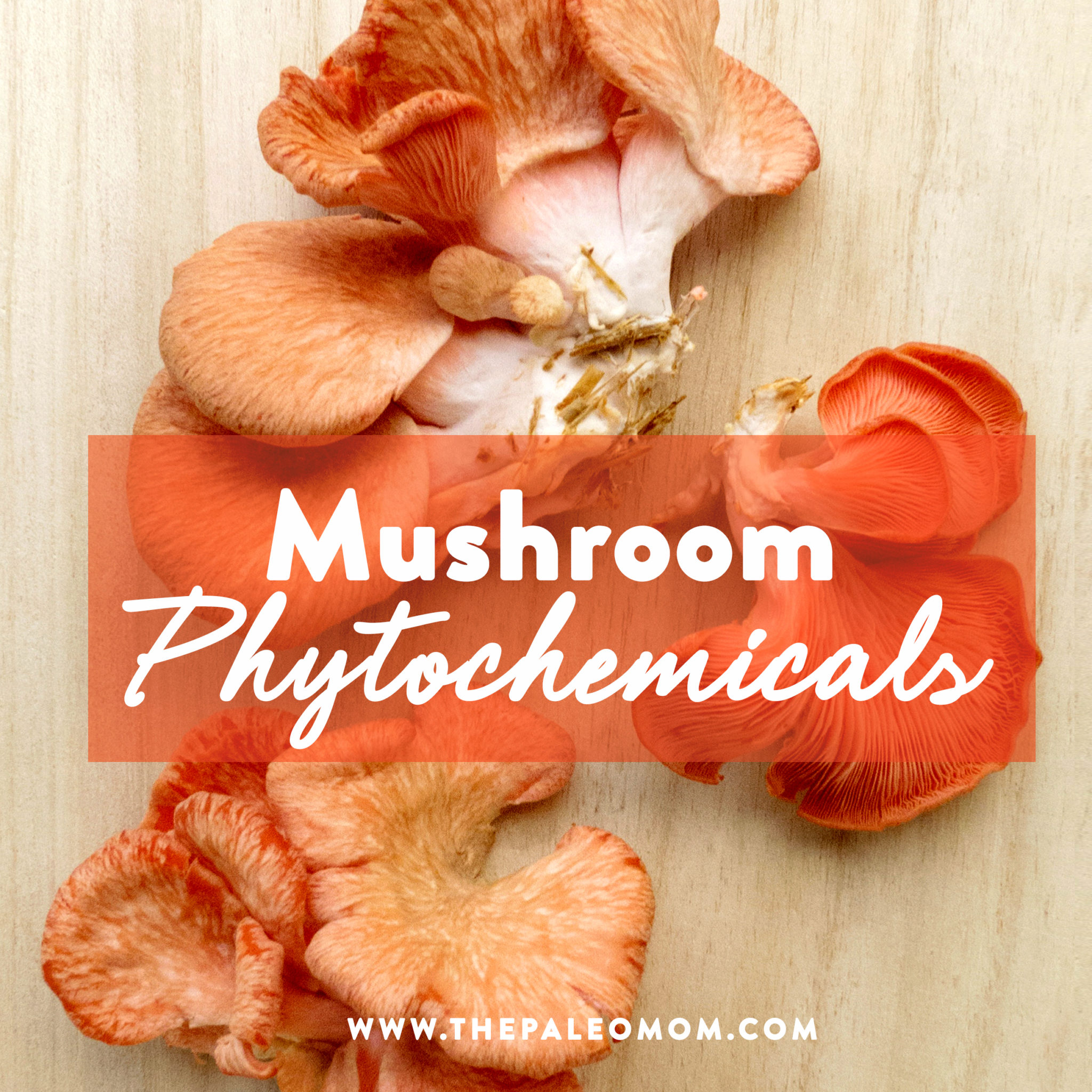
Mushrooms are well-understood sources of nutraceuticals, specific phytochemicals that provide a medicinal benefit. See also The Amazing World of Plant Phytochemicals: Why a diet rich in veggies is so important! and Polyphenols: Magic Bullet or Health Hype?
Nutrivore Weekly Serving Matrix
An easy-to-use and flexible weekly checklist
to help you maximize nutrient-density.
The Weekly Serving Matrix is very helpful! I’ve been eating along these lines but this really helps me know where to focus vs. which foods serve a more secondary role. It’s super helpful and has taken a lot of worry out of my meal planning. Thanks!
Jan
In fact, several nutraceuticals extracted from mushrooms form the basis of cancer drugs. For example, the drug lentinan is derived from skiitake mushrooms and is used in several countries to boost the efficacy of medications used to treat cancer and HIV infection. (In the USA, lentinan is considered a dietary supplement and there is more research needed to confirm efficacy in cancer and HIV treatment.) Another drug, called polysaccharide-K (the brand name is Krestin), is derived from Turkey Tail, and is an approved adjuvant for cancer therapy in Europe and Japan. There is some very exciting drug development research being conducted on specific phytochemicals derived from mushrooms, but I’m not sharing this information to make a case for medicinal mushrooms as a first-line treatment for any condition. Rather, I want to emphasize the benefits of eating a variety of whole mushroom, which each contain hundreds of such health-benefitting chemicals.
Mushrooms are particularly rich in phenolic compounds, including:
- protocatechuic acid. Studies suggest protocatechuic acid is a potent antioxidant that can reduce inflammation, protect the liver from damage, prevent cancer, protect against ulcers, and protect against cardiovascular disease, in addition to both anti-viral and anti-bacterial properties.
- gentisic acid. Studies suggest gentisic acid has anti-inflammatory, antirheumatic and antioxidant properties, can protect cells from damage caused by gamma radiation, can protect the liver from damage, and enhances antioxidant enzyme activity.
- gallic acid. Studies show that gallic acid has potent antioxidant effects, reduces inflammation, and may protect against cardiovascular disease, cancer, and infection. In fact, gallic acid may prove useful in the treatment of depression, cancer, and some types of infection.
- vanillic acid. Studies show that vanillic acid has antioxidant and anti-inflammatory properties and may even act as a pain reliever. It’s also cardioprotective, hepatoprotective, anti-fungal and anti-bacterial.
- p-coumaric acid. Studies suggest p-coumaric acid can reduce inflammation, reduce intestinal inflammation, regulate the immune system, improve bone density, act as an antidepressant, prevent cancer, protect against kidney damage, and protect against tissue damage caused by drugs and alcohol.
- cinnamic Another potent antioxidant, studies suggest that cinnamic acid has antibacterial, antiviral and antifungal properties in addition to protecting against cancer and diabetes.
- syringic acid. Studies show that syringic acid may protect against cancer, diabetes, liver damage and lung damage.
- myricetin. Studies show that myricetin is a superstar thanks to its strong anti-oxidant, anticancer, antidiabetic and anti-inflammatory activities. It may protect against neurodegenerative diseases such as Parkinson’s and Alzheimer’s, as well as cardiovascular disease, liver damage, and glaucoma. Myricetin also protects against photoaging, thrombosis, hypertention, allergies and can even act as a pain reliever!
- catechin. Studies show that catechins act as antioxidants but also boost the activity of antioxidant enzymes. Catechins are also anti-inflammatory and modulate the immune system, anti-bacterial, anti-cancer and can boost metabolism and promote healthy weight loss.
Mushrooms are also particularly rich in triterpenes (including ergosterol, ganoleucoin, ganoderic acid and pyrrole alkaloids), which have a variety of properties that are important for cancer prevention, including antiproliferative, antimetastatic, and antiangiogenic. About 80 different triterpenes have been isolated from reishi alone, some of which are known to kill hepatoma cells (liver cancer cells), to inhibit histamine release from mast cells (anti-allergic effect), to have cardioprotective effects (by modulating angiotensin) and hepatoprotective activity.
Impressive, right? And yet, the benefits of mushroom phytochemicals can’t hold a candle to the gut microbiome benefits of mushroom fiber!
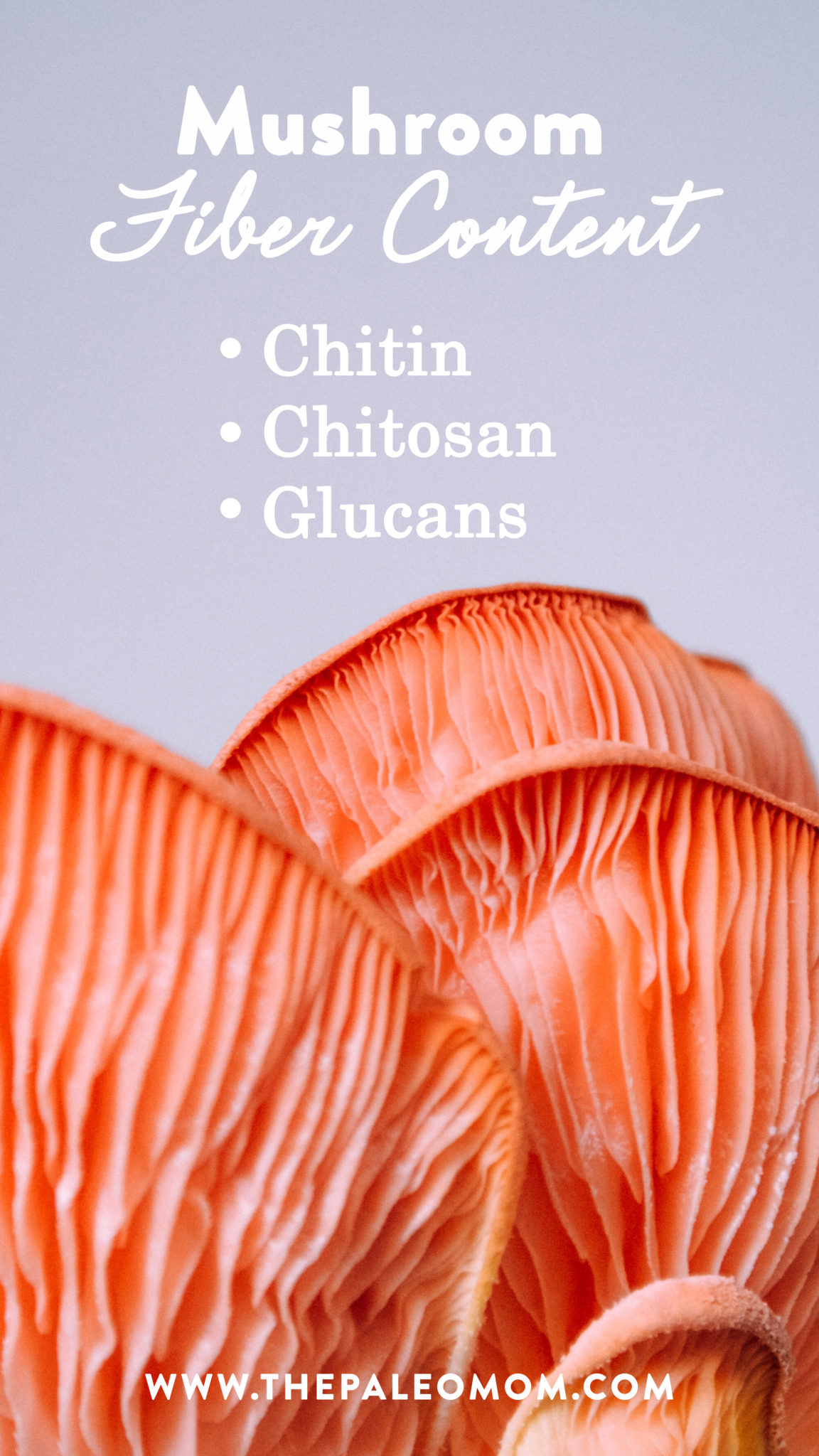 Mushrooms’ Unique Fiber Content
Mushrooms’ Unique Fiber Content
Mushrooms contain about 50% carbohydrate by weight, including several types of fiber that can’t be readily obtained from other foods. Their carbohydrate structure includes chitin, beta- and alpha-glucans, mannans, xylans, galactans, and hemicellulose, which collectively feed a wide range of bacterial species. See also What Is the Gut Microbiome? And Why Should We Care About It?, The Fiber Manifesto-Part 1 of 5: What Is Fiber and Why Is it Good?, and The Fiber Manifesto-Part 2 of 5: The Many Types of Fiber.
Let’s hone in on the three types of fiber that make mushrooms such unique gut microbiome superstars: chitin, chitosan, and beta-glucan.
Chitin is a type of fermentable oligosaccharide fiber made of long chains of a glucose derivative called N-acetylglucosamine with amino acids attached. It can only be obtained from mushrooms and other fungi, insect exoskeletons, fish scales, and shellfish shells. In studies, chitin has been shown to support the growth of species from Bifidobacterium (including Bifidobacterium animalis), Lactobacillus, Akkermansia, and Bacteroides while also decreasing the abundance of the inflammatory microbe Desulfovibrio. In mice, chitin oligosaccharides are also able to modulate the gut microbiota to combat diet-induced metabolic syndrome in mice, inhibiting the destruction of the gut barrier, restoring the Firmicutes to Bacteroidetes ratio to what it was before high-fat feeding, and reversing the decreases in Porphyromonadaceae, Deferribacteraceae, and Coriobacteriaceae and the increases in Rhodospirillaceae, Christensenellaceae, Bacteroidaceae, Lactobacillaceae, Bifidobacteriaceae, Verrucomicrobiaceae, and Erysipelotrichaceae induced by high-fat feeding. At the genus level, chitin fiber dramatically increased levels of Bifidobacterium, Lactobacillus, Akkermansia, and Bacteroides in these mice, while decreasing the abundance of the less favorable Desulfovibrio. In human fecal culture, chitin-glucan fiber also beneficially increases the Lactobacillus/Enterococcus ratio.
Chitosan is also composed of a long chain of N-acetylglucosamine molecules, but it also contains randomly distributed D-glucosamine molecules linked in a beta configuration. It is only naturally-occurring in the cell walls of fungi, like mushrooms. In mice, chitosan increases gut microbial diversity (along with a general increase in Bacteroidetes and a decrease in Firmicutes) and decreases levels of potentially pathogenic genera Escherichia and Shigella. In diabetic mice, chitosan has also been shown to reshape the microbiota to induce an anti-diabetic effect, relieving dysbiosis by raising levels of Akkermansia muciniphilia and suppressing the growth of Helicobacter.
Glucans are polysaccharides derived from D-glucose, linked by either alpha-glycosidic bonds (making them alpha-glucans) or beta-glycosidic bonds (making them beta-glucans). Mushrooms are particularly rich sources of beta-glucans (more specifically (1-3),(1-6)-beta-glucans which are different than the (1,4)-beta-glucans in grains like oats), which feed anaerobic microbes in the gut and can significantly increase levels of, butyric and propionic acids (the second best source of beta-glucans is oats). Beta-glucans have been shown to increase levels of Roseburia, Bifidobacterium and Dialister, and in particular the species Eubacterium rectale, Roseburia faecis, and Roseburia intestinalis. In a human trial, foods rich in beta-glucan, increased levels of Roseburia hominis, Clostridiaceae (Clostridium orbiscindens and probiotic Clostridium species), and Ruminococcus species, while lowering the levels of Firmicutes and Fusobacteria were lowered. Levels of acetic, butyric, and propionic acids also increased. In vitro studies have also demonstrated that beta-glucan can boost the growth of Lactobacillus acidophilus, Lactobacillus casei, and Bifidobacterium animalis lactis. In an extensive review of the health effects of beta-glucan, researchers concluded that this fiber’s actions upon the gut microflora, including enhancing the production of short-chain fatty acids, contributes to its anti-cancer, anti-inflammatory, anti-diabetic, and immune-modulating effects.
 Each mushroom variety has its own unique nutrient composition and can impact the microbiome in different beneficial ways. For example, Ganoderma lucidium (reishi mushroom) increases the relative abundance of Lactobacillus, Roseburia, and Lachnospiraceae in the gut. In mice, these mushrooms have also been reported to reduce obesity through modulation of the gut microbiota, to reverse gut dysbiosis, to maintain intestinal barrier integrity, and to reduce endotoxemia. Inonotus obliquus (chaga mushroom) contains polysaccharides that exert anti-tumor effects in colorectal cancer and that can increase Bacteroidetes at the phylum level, bringing the gut microbial profile closer to a healthy composition. Coriolus versicolor (turkey tail mushroom) contains polysaccharopeptide, which can modify Bifidobacterium and Lactobacillus species and elicit host responses that subsequently regulate the gut microbiome. In mice, Agaricus bisporus (white button mushroom) have been shown to increase microbial diversity and expedite healing from Citrobacter rodentium infection, improving the composition of the gut microbiome. These mushrooms have also been shown to change the intestinal microbiota composition in turkey poults, increasing the levels of lactic acid producing bacteria and subsequently improving the overall condition of the intestine. Lentinula edodes (shiitake mushroom) polysaccharides can alter the spatial structure of rodent gut microbiomes, altering levels of a wide range of bacterial populations including Proteobacteria, Acidifcaciens, Helicobacter suncus, Bacteroides, and Alistipes. Phellinus linteus (black hoof mushroom) and Hericium erinaceus (lion’s mane) both induce changes in the gut microbiome that increase the bacterial production of nutrients for the host. Several species of Pleurotus, including Pleurotus ostreatus (oyster mushroom), Pleurotus sajor-caju, and Pleurotus abalonus have significant prebiotic effects and can stimulate the growth of Bifidobacterium strains including B. bifidum TISTR 2129, B. breve TISTR 2130, B. animalis TISTR 2195, and B. longum TISTR 2194.
Each mushroom variety has its own unique nutrient composition and can impact the microbiome in different beneficial ways. For example, Ganoderma lucidium (reishi mushroom) increases the relative abundance of Lactobacillus, Roseburia, and Lachnospiraceae in the gut. In mice, these mushrooms have also been reported to reduce obesity through modulation of the gut microbiota, to reverse gut dysbiosis, to maintain intestinal barrier integrity, and to reduce endotoxemia. Inonotus obliquus (chaga mushroom) contains polysaccharides that exert anti-tumor effects in colorectal cancer and that can increase Bacteroidetes at the phylum level, bringing the gut microbial profile closer to a healthy composition. Coriolus versicolor (turkey tail mushroom) contains polysaccharopeptide, which can modify Bifidobacterium and Lactobacillus species and elicit host responses that subsequently regulate the gut microbiome. In mice, Agaricus bisporus (white button mushroom) have been shown to increase microbial diversity and expedite healing from Citrobacter rodentium infection, improving the composition of the gut microbiome. These mushrooms have also been shown to change the intestinal microbiota composition in turkey poults, increasing the levels of lactic acid producing bacteria and subsequently improving the overall condition of the intestine. Lentinula edodes (shiitake mushroom) polysaccharides can alter the spatial structure of rodent gut microbiomes, altering levels of a wide range of bacterial populations including Proteobacteria, Acidifcaciens, Helicobacter suncus, Bacteroides, and Alistipes. Phellinus linteus (black hoof mushroom) and Hericium erinaceus (lion’s mane) both induce changes in the gut microbiome that increase the bacterial production of nutrients for the host. Several species of Pleurotus, including Pleurotus ostreatus (oyster mushroom), Pleurotus sajor-caju, and Pleurotus abalonus have significant prebiotic effects and can stimulate the growth of Bifidobacterium strains including B. bifidum TISTR 2129, B. breve TISTR 2130, B. animalis TISTR 2195, and B. longum TISTR 2194.
The benefits of mushroom fiber to the gut microbiome make a strong case for their frequent inclusion in our diets. Studies show that gut microbiome composition can shift dramatically in response to changes in diet in as little as 2 to 3 days. That means that we need to be thinking of this time scale as the life cycle of our gut bacteria. For all those probiotic species that love mushroom fiber, we can best support them when we eat mushrooms ideally daily and at least as often as every three days.
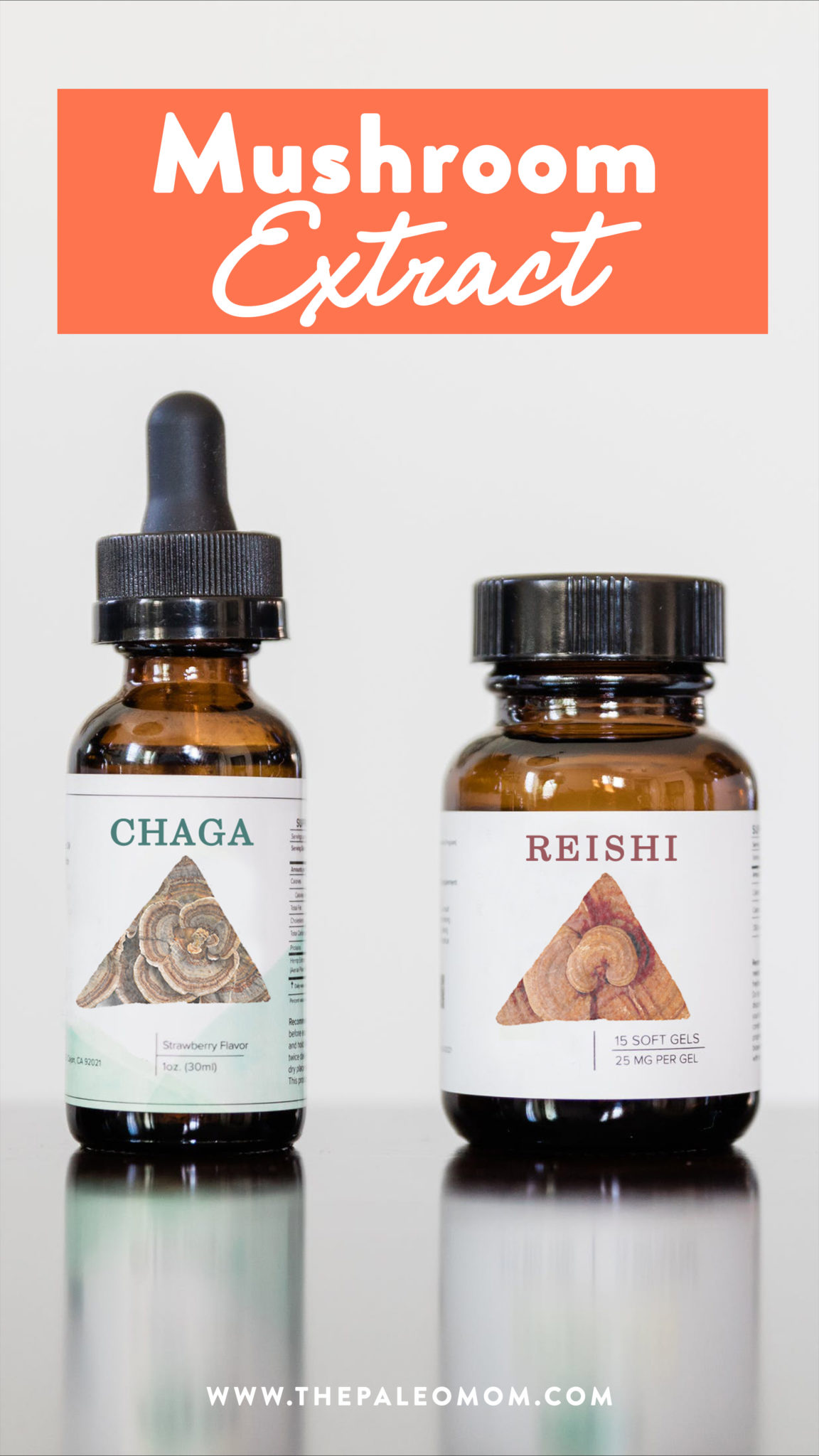 From the Frying Pan to the Extract?
From the Frying Pan to the Extract?
This body of evidence makes a strong case for including a variety of whole mushrooms in our diets, including species identified as having medicinal properties. But what about mushroom extracts?
This will be the topic of an upcoming blog post, but let’s also briefly discuss here. Medicinal mushroom extracts are typically made via a 2-step process to extract first water-soluble compounds (polysaccharides) and then less soluble compounds (triterpenes and phenolics, which are extracted with alcohol). Extracts contain hundreds if not thousands of different molecules. Some studies use purified extracts (just the water-soluble fraction or the alcohol extraction), double extracts, freeze-dried powders, or even isolated compounds. It can be hard to extrapolate from a study that uses a specific extract to a double-extraction solution to whole mushrooms.
In general, cooking with the whole mushroom is the best way to make sure you’re reaping the full range of health benefits that mushrooms have to offer. And, while mushroom extracts typically provide a wide-range of benefits, this is where things can get complicated. Let’s look at reishi extract as an example.
Some beta-glucans (which are concentrated in water and double extracts), are very small molecules, so they can actually bind to immune cells directly, thereby affecting immune activity in addition to the indirect effects mediated by the gut microbiome. This fact provided the original rationale for avoiding medicinal mushroom extracts on the Autoimmune Protocol. For example, reishi extract, which has been well-studied for its anti-cancer effects, activates natural killer cells, increasing the immune system’s capacity to fight tumors, and reduces risk of metastasis. Because the way in which the immune system is imbalanced in cancer (underactive effector cells and overactive regulatory cells) can be thought of as the opposite to the imbalance in autoimmune disease (underactive regulatory cells and overactive effector cells), autoimmune disease sufferers must necessarily be wary of any substance that stimulates the immune system in a way that’s specifically beneficial in the context of cancer. See The Link Between Cancer and Autoimmune Disease
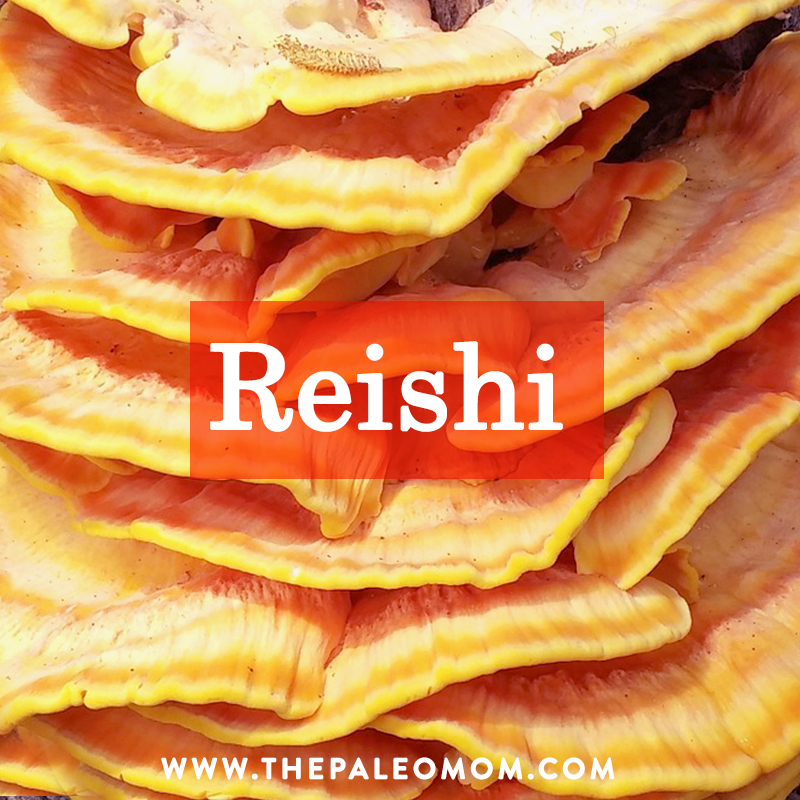 However newer studies reveal that reishi extract is immune modulatory rather than immune stimulatory. Two studies in rheumatoid arthritis patients showed decreased joint pain concurrent with a decrease in interleukin(IL)-18, which very potently activates Th1 cells (there was also no increase in any measured inflammatory cells or other cytokines). One mouse lupus study showed that reishi extract supplementation caused a decrease in autoantibodies and increased survival. A subsequent mouse lupus study showed that reishi increased the ratio of regulatory T cells to Th17 and Th1 cells with concurrent changes in cytokines, including decreases in IL-21, IL-10 and IL-17 and increases in IL-2 and IL-12P70. Finally, a mouse model of autoimmune Alzheimer’s disease (a suspected autoimmune disease) showed changes in gene expression that correlated with reduced disease activity thanks to reishi supplementation.
However newer studies reveal that reishi extract is immune modulatory rather than immune stimulatory. Two studies in rheumatoid arthritis patients showed decreased joint pain concurrent with a decrease in interleukin(IL)-18, which very potently activates Th1 cells (there was also no increase in any measured inflammatory cells or other cytokines). One mouse lupus study showed that reishi extract supplementation caused a decrease in autoantibodies and increased survival. A subsequent mouse lupus study showed that reishi increased the ratio of regulatory T cells to Th17 and Th1 cells with concurrent changes in cytokines, including decreases in IL-21, IL-10 and IL-17 and increases in IL-2 and IL-12P70. Finally, a mouse model of autoimmune Alzheimer’s disease (a suspected autoimmune disease) showed changes in gene expression that correlated with reduced disease activity thanks to reishi supplementation.
The picture these data paint is one of medicinal mushroom extracts (at least in the case of reishi) being beneficial in instances of under-active immune systems (such as in common cold and flu season), overactive immune function (such as in cases of autoimmune diseases), and carcinogenesis (such as in the growth of tumors and metastatic cancers). However, there is clearly a great need for additional research to confirm this before reishi and other medicinal mushroom extracts earn the explicit go-ahead in autoimmune disease sufferers. In the meantime, only whole mushrooms are included during the elimination phase of the Autoimmune Protocol (yes, even including medicinal mushrooms like shiitake, maitake and oyster).
Read more about medicinal mushroom extracts in The Power of Medicinal Mushrooms: An Overview.
Mushrooms for the Win!
In summary, mushrooms are uniquely beneficial for the gut microbiome while providing a tantalizing density of essential nutrients and beneficial phytochemicals. we can all benefit from eating a variety of whole mushrooms, ideally daily.
Looking for an easy way to add the benefits of mushrooms into your daily life? I have fallen in love with Real Mushrooms, who (IMO) make the highest possible quality medicinal mushroom extracts. The mushrooms are wild-harvested, organic and sustainably-sourced and you’ll always find a measurement of beta-glucans and triterpenoids (where applicable) on their labels. Plus, all of the products are free of starch, grain and fillers (surprisingly common in mushroom extracts). They make powders that are easy to add to coffee or a smoothie, capsules that make getting your daily serving of mushroom super easy, and even dairy-free dark chocolate made with extracts from five different mushrooms!
Citations
Anwar H, Suchodolski JS, Ullah MI, Hussain G, Shabbir MZ, Mustafa I, Sohail MU. Shiitake Culinary-Medicinal Mushroom, Lentinus edodes (Agaricomycetes), Supplementation Alters Gut Microbiome and Corrects Dyslipidemia in Rats. Int J Med Mushrooms. 2019;21(1):79-88.
Bao YX, Wong CK, Li EK, Tam LS, Leung PC, Yin YB, Lam CW. Immunomodulatory effects of lingzhi and san-miao-san supplementation on patients with rheumatoid arthritis. Immunopharmacol Immunotoxicol. 2006;28(2):197-200.
Bhardwaj N, Katyal P, Sharma AK. Suppression of inflammatory and allergic responses by pharmacologically potent fungus Ganoderma lucidum. Recent Pat Inflamm Allergy Drug Discov. 2014;8(2):104-17.
Cai Z, Wong CK, Dong J, Jiao D, Chu M, Leung PC, Lau CBS, Lau CP, Tam LS, Lam CWK. Anti-inflammatory activities of Ganoderma lucidum (Lingzhi) and San-Miao-San supplements in MRL/lpr mice for the treatment of systemic lupus erythematosus. Chin Med. 2016 Apr 29;11:23.
Carlson JL, Erickson JM, Hess JM, Gould TJ, Slavin JL. Prebiotic Dietary Fiber and Gut Health: Comparing the in Vitro Fermentations of Beta-Glucan, Inulin and Xylooligosaccharide. Nutrients. 2017 Dec 15;9(12). pii: E1361.
Chang CJ, Lin CS, Lu CC, Martel J, Ko YF, Ojcius DM, Tseng SF, Wu TR, Chen YY, Young JD, Lai HC. Ganoderma lucidum reduces obesity in mice by modulating the composition of the gut microbiota. Nat Commun. 2015 Jun 23;6:7489.
Delzenne NM, Bindels LB. Gut microbiota: Ganoderma lucidum, a new prebiotic agent to treat obesity? Nat Rev Gastroenterol Hepatol. 2015 Oct;12(10):553-4.
Friedman M. Mushroom Polysaccharides: Chemistry and Antiobesity, Antidiabetes, Anticancer, and Antibiotic Properties in Cells, Rodents, and Humans. Foods. 2016 Nov 29;5(4). pii: E80. doi: 10.3390/foods5040080.
Guan G, Wang H, Chen S, Liu G, Xiong X, Tan B, Duraipandiyan V, Al-Dhabi NA, Fang J. Dietary Chitosan Supplementation Increases Microbial Diversity and Attenuates the Severity of Citrobacter rodentium Infection in Mice. Mediators Inflamm. 2016;2016:9236196.
Holmes D. Obesity: Medicinal mushroom reduces obesity by modulating microbiota. Nat Rev Endocrinol. 2015 Sep;11(9):504.
Jayachandran M, Xiao J, Xu B. A Critical Review on Health Promoting Benefits of Edible Mushrooms through Gut Microbiota. Int J Mol Sci. 2017 Sep 8;18(9). pii: E1934.
Lai NS, Lin RH, Lai RS, Kun UC, Leu SC. Prevention of autoantibody formation and prolonged survival in New Zealand Black/New Zealand White F1 mice with an ancient Chinese herb, Ganoderma tsugae. Lupus. 2001;10(7):461-5.
Li EK, Tam LS, Wong CK, Li WC, Lam CW, Wachtel-Galor S, Benzie IF, Bao YX, Leung PC, Tomlinson B. Safety and efficacy of Ganoderma lucidum (lingzhi) and San Miao San supplementation in patients with rheumatoid arthritis: a double-blind, randomized, placebo-controlled pilot trial. Arthritis Rheum. 2007 Oct 15;57(7):1143-50.
Liu DZ. A review of ergostane and cucurbitane triterpenoids of mushroom origin. Nat Prod Res. 2014;28(14):1099-105. doi: 10.1080/14786419.2014.900767. Epub 2014 Mar 28
Ludwiczuk, K. Skalicka-Woźniak, M.I. Georgiev. Chapter 11 – Terpenoids. Ed: Simone Badal, Rupika Delgoda. Pharmacognosy. Academic Press, 2017, Pages 233-266, ISBN 9780128021040
Nanri A, Mizoue T, Shimazu T, Ishihara J, Takachi R, Noda M, Iso H, Sasazuki S, Sawada N, Tsugane S; Japan Public Health Center-Based Prospective Study Group. Dietary patterns and all-cause, cancer, and cardiovascular disease mortality in Japanese men and women: The Japan public health center-based prospective study. PLoS One. 2017 Apr 26;12(4):e0174848. doi: 10.1371/journal.pone.0174848.
Osonoi Y, Mita T, Osonoi T, Saito M, Tamasawa A, Nakayama S, Someya Y, Ishida H, Kanazawa A, Gosho M, Fujitani Y, Watada H. Relationship between dietary patterns and risk factors for cardiovascular disease in patients with type 2 diabetes mellitus: a cross-sectional study. Nutr J. 2016 Feb 4;15:15. doi: 10.1186/s12937-016-0132-6
Palacios I., Lozano M., Moro C., et al. Antioxidant properties of phenolic compounds occurring in edible mushrooms. Food Chemistry. 2011;128(3):674–678. doi: 10.1016/j.foodchem.2011.03.085
Qin C, Wu S, Chen B, Wu X, Qu K, Liu J, Zhang G, Xu Y, Shu S, Sun L, Li Y, Zhu H, Huang L, Ma C, Xu Y, Han Y, Lu Y. Effect of Ganoderma Lucidum Preparation on the Behavior,Biochemistry,and Autoimmune Parameters of Mouse Models of APP/PS1 Double Transgenic Alzheimer’s Disease. Zhongguo Yi Xue Ke Xue Yuan Xue Bao. 2017 Jun 20;39(3):330-335.
Rahi DK, Malik D. Diversity of Mushrooms and Their Metabolites of Nutraceutical and Therapeutic Significance. Journal of Mycology, vol. 2016, Article ID 7654123, 18 pages, 2016. https://doi.org/10.1155/2016/7654123.
Valverde ME, Hernández-Pérez T, Paredes-López O. Edible mushrooms: improving human health and promoting quality life. Int J Microbiol. 2015;2015:376387. doi: 10.1155/2015/376387. Epub 2015 Jan 20.
Vamanu E, Gatea F, Sârbu I. In Vitro Ecological Response of the Human Gut Microbiome to Bioactive Extracts from Edible Wild Mushrooms. Molecules. 2018 Aug 23;23(9). pii: E2128
Varshney J, Ooi JH, Jayarao BM, Albert I, Fisher J, Smith RL, Patterson AD, Cantorna MT. White button mushrooms increase microbial diversity and accelerate the resolution of Citrobacter rodentium infection in mice. J Nutr. 2013 Apr;143(4):526-32.
Zheng J, Cheng G, Li Q, Jiao S, Feng C, Zhao X, Yin H, Du Y, Liu H. Chitin Oligosaccharide Modulates Gut Microbiota and Attenuates High-Fat-Diet-Induced Metabolic Syndrome in Mice. Mar Drugs. 2018 Feb 19;16(2). pii: E66
Zheng J, Yuan X, Cheng G, Jiao S, Feng C, Zhao X, Yin H, Du Y, Liu H. Chitosan oligosaccharides improve the disturbance in glucose metabolism and reverse the dysbiosis of gut microbiota in diabetic mice. Carbohydr Polym. 2018 Jun 15;190:77-86.

